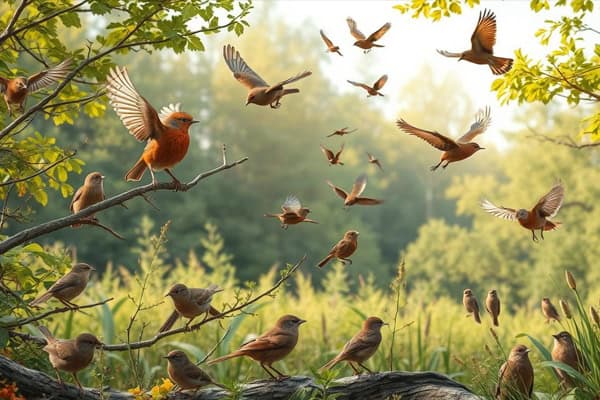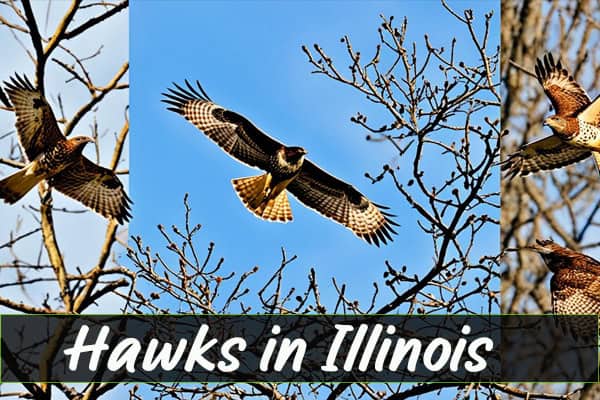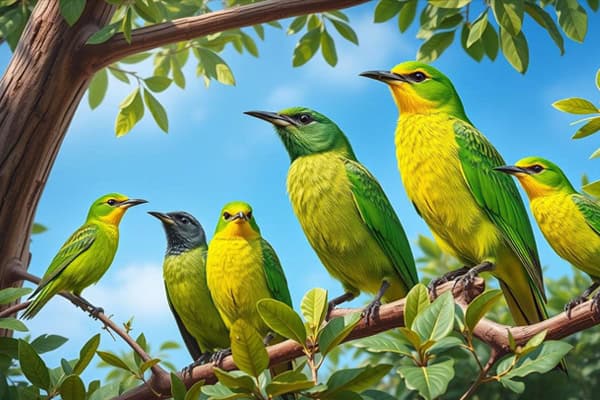Brown Birds In Michigan (12 Large and Small Species)
Did you know nearly 40% of Michigan birds are brown? These birds have a special charm that draws in bird watchers and nature lovers. They are vital to our local ecosystems, whether we’re in the suburbs or the wild.
This article will take you into the world of brown birds in Michigan. We’ll look at different species you might see while bird watching. From the big Red-winged Blackbird to the small House Finch, we’ll cover their homes, what they eat, and how to tell them apart. Let’s dive into the world of bird watching and see the beauty in Michigan’s brown birds.
Common Brown Birds Found in Michigan
- Red-winged Blackbird
- Brown-headed Cowbird
- House Finch
- House Sparrow
- Song Sparrow
- White-crowned Sparrow
- White-throated Sparrow
- Chipping Sparrow
Common Characteristics of Brown Birds
Brown birds have many traits that help them survive and adapt. They come in various sizes and have different feather patterns and beak shapes. These features are key to their success in many environments.
Most brown birds have brown or tan feathers. These colors help them hide from predators. Some have streaks or spots that make them blend in even better with their surroundings.
Brown birds also have interesting behaviors. They might look for seeds, insects, or fruits to eat. Some birds like to be alone, while others join groups for safety and to find food together. These behaviors show how adaptable and tough they are.
| Characteristic | Description |
|---|---|
| Coloration | Varied shades of brown and tan for camouflage. |
| Feather Patterns | Streaks and spots for enhanced blending with surroundings. |
| Beak Shapes | Adapted for eating specific diets (seeds, insects, etc.). |
| Feeding Behavior | Includes ground foraging and gleaning on plants. |
| Social Structure | Ranges from solitary to social flocks for safety. |
Large Brown Bird Species
We’re going to look at two big brown birds in Michigan: the Red-winged Blackbird and the Brown-headed Cowbird. These birds stand out because of their looks and how they act.
1. Red-winged Blackbird
- Scientific Name: Agelaius phoeniceus
- Size: 17-23 cm (6.7-9.1 inches)
- Diet: Insects and seeds
- Weight: 32-77 grams (1.1-2.7 ounces)
The Red-winged Blackbird is known for its bright male plumage. It has a red and yellow patch on its shoulder. The female looks more brown. Males sing to protect their territory during breeding season. Females gather nesting materials in wet areas.
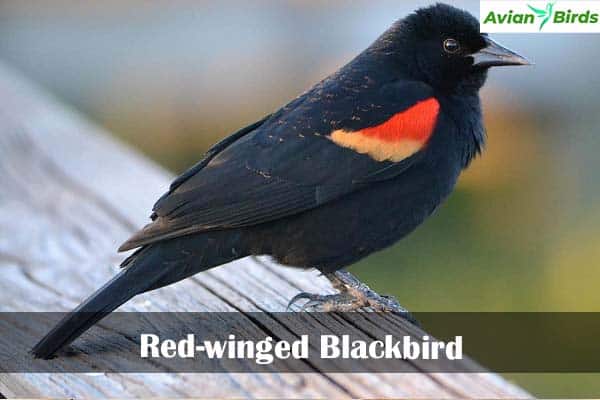
This bird shows how males and females can look very different. It’s a great example of sexual dimorphism.
2. Brown-headed Cowbird
- Scientific Name: Molothrus ater
- Size: 16-22 cm (6.3-8.7 inches)
- Diet: Seeds and insects
- Weight: 30-60 grams (1.1-2.1 ounces)
The Brown-headed Cowbird is known for a unique way of reproducing called brood parasitism. They lay eggs in other birds’ nests, leaving the host to care for their young. They are small and have a brown head, making them easy to miss.
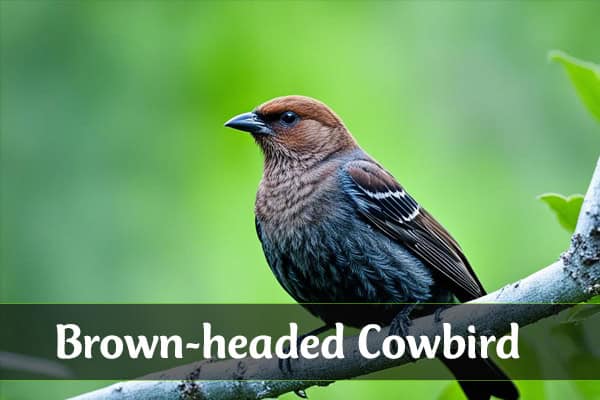
To spot them, look for their size compared to other birds. Their behavior helps us understand how they live with other birds.
| Species | Male Appearance | Female Appearance | Behavior |
|---|---|---|---|
| Red-winged Blackbird | Black with red and yellow shoulder patch | Mottled brown with streaks | Sings to establish territory |
| Brown-headed Cowbird | Glossy black with a brown head | Similar drab brown coloring | Practices brood parasitism |
Small Brown Bird Species
Michigan is home to many small brown birds that are often overlooked. These birds have subtle colors and sing sweet songs. They add to the state’s rich biodiversity. Let’s look at some common small brown bird species found here.
3. House Finch
- Scientific Name: Haemorhous mexicanus
- Size: 12-15 cm (4.7-5.9 inches)
- Diet: Seeds, fruits, and insects
- Weight: 16-27 grams (0.6-1.0 ounce)
The house finch is common in urban areas, showing how well it adapts to human environments. Males have bright red on their heads and chests. Females are more brown. Their songs make gardens more musical.

4. House Sparrow
- Scientific Name: Passer domesticus
- Size: 14-18 cm (5.5-7.1 inches)
- Diet: Seeds, grains, and insects
- Weight: 24-40 grams (0.8-1.4 ounces)
The house sparrow is seen in city parks and gardens. Males have black and white on them, while females are plain brown. They are often found in large groups, looking for food.
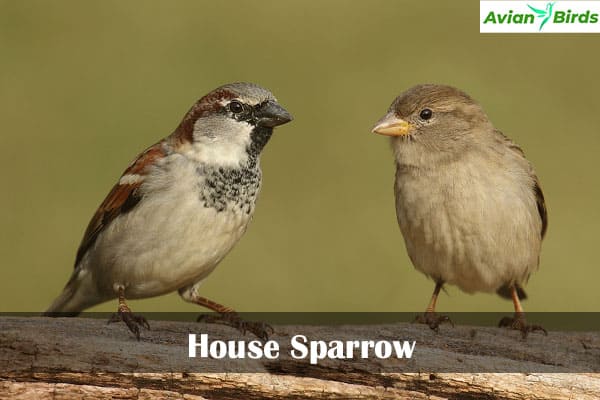
5. Song Sparrow
- Scientific Name: Melospiza melodia
- Size: 12-17 cm (4.7-6.7 inches)
- Diet: Seeds, fruits, and insects
- Weight: 18-28 grams (0.6-1.0 ounce)
Song sparrows are known for their beautiful singing. They have streaked feathers that help them blend in. Seeing their unique markings is a treat for birdwatchers.
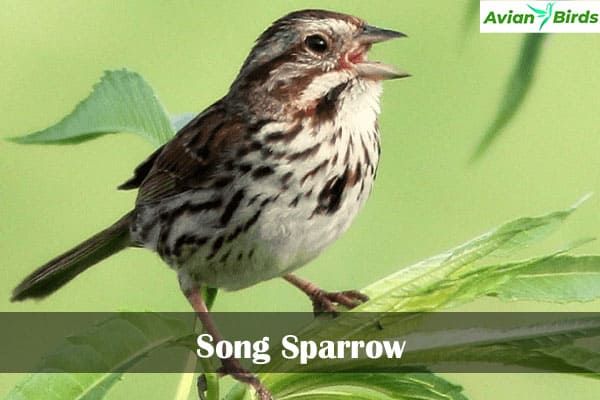
6. White-crowned Sparrow
- Scientific Name: Zonotrichia leucophrys
- Size: 15-18 cm (5.9-7.1 inches)
- Diet: Seeds, fruits, and insects
- Weight: 25-30 grams (0.9-1.1 ounces)
The white-crowned sparrow is easy to spot with its black and white head stripes. They like shrubs and come to feeders with sunflower seeds. Their songs are sweet and can be heard in spring.
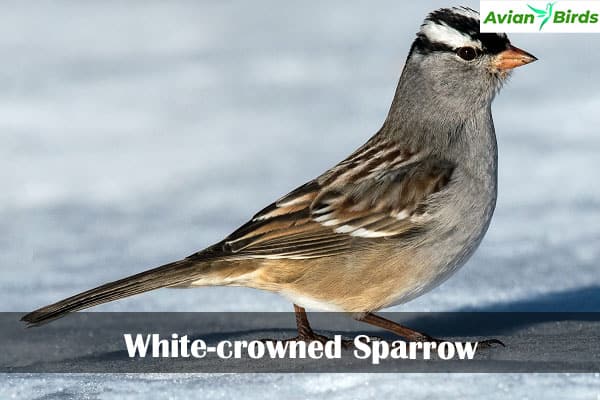
7. White-throated Sparrow
- Scientific Name: Zonotrichia albicollis
- Size: 15-17 cm (5.9-6.7 inches)
- Diet: Seeds, fruits, and insects
- Weight: 22-32 grams (0.8-1.1 ounces)
The white-throated sparrow is known for its elegant white throat patch. They live in forests and visit feeders with mixed seeds. They are a joy to see for those who wait patiently in the woods.
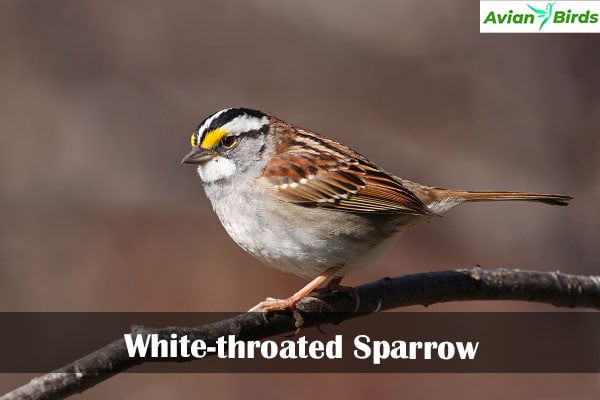
8. Chipping Sparrow
- Scientific Name: Spizella passerina
- Size: 12-15 cm (4.7-5.9 inches)
- Diet: Seeds and insects
- Weight: 11-16 grams (0.4-0.6 ounces)
The chipping sparrow has a slender tail and sings a short song. They are often seen in yards and enjoy living near people. They are common in neighborhoods because they like open areas and nest near homes.

| Species | Identifying Features | Preferred Habitat | Diet |
|---|---|---|---|
| House Finch | Bright red markings (males), brown streaks (females) | Urban areas, gardens | Seeds, fruits |
| House Sparrow | Black and white markings (males), brown (females) | Cities, parks, gardens | Bread, seeds |
| Song Sparrow | Streaked plumage, melodious song | Wetlands, gardens | Seeds, insects |
| White-crowned Sparrow | Black and white head stripes | Shrubby areas | Seeds, fruits |
| White-throated Sparrow | White throat patch | Forest edges | Seeds, berries |
| Chipping Sparrow | Short song, slender tail | Suburban areas, open fields | Seeds, insects |
Habitat Preferences of Brown Birds
Brown birds live in many places in Michigan, showing how adaptable they are. Each place they live has special things they need for food and homes.
Wetlands are a key place for brown birds. They have lots of food like insects and seeds. The Red-winged Blackbird loves these areas.
Grasslands are also important. Birds like the House Sparrow live here because they can easily find food in the grass.
Forests give brown birds a place to hide and nest. The Song Sparrow likes living here because of the thick trees. Some birds even live in cities, finding food in gardens and parks.
Brown birds move to different places during the year. This is because the food changes with the seasons. In winter, some birds go to cities where they can find more food.
| Habitat Type | Preferred Brown Bird Species | Key Resources |
|---|---|---|
| Wetlands | Red-winged Blackbird | Insects, seeds |
| Grasslands | House Sparrow | Seeds, insects |
| Forests | Song Sparrow | Fruits, insects |
| Urban Areas | House Finch | Food scraps, seeds |
Brown birds are very good at living in different places in Michigan. They show how well they can adapt to different environments. By understanding where they live, we learn more about these interesting birds.
Feeding Habits of Brown Birds
Learning about birds’ eating habits shows us how interesting they are. In Michigan, brown birds like different foods based on where they live. Many, like the House Sparrow and the Red-winged Blackbird, eat seeds and grains a lot.
During the breeding season, these birds eat insects too. This gives them the protein they need for their babies. In our yards, we see them gather at feeders for sunflower seeds, millet, and more.
- Put out different seeds, like sunflower and safflower, to draw in various birds.
- Place feeders at different heights for ground and high-flying birds.
- Keep feeders clean to stop seeds from going bad.
- Make sure there’s fresh water, especially when it’s hot.
By knowing what they like to eat, we can make our yards better for brown birds. Watching these birds can be very rewarding. It turns our yards into lively places.
Check Our Previous Articles:
| Yellow Birds in Colorado |
| Black Birds in Michigan |
| Owls in Indiana |
| Learn About the White-Naped Crane |
| Mandarin Duck: Everything You Need To Know |
Conclusion
In this journey, we’ve explored Michigan’s brown birds and their special traits. We’ve seen how they add to our local ecosystems. From the big Red-winged Blackbird to the small Song Sparrow, there’s a lot to discover and enjoy.
We urge everyone to go outside and watch the birds. By watching these birds in our yards and neighborhoods, we connect more with nature. It’s fun to learn their songs and behaviors, making bird-watching great for all ages.

